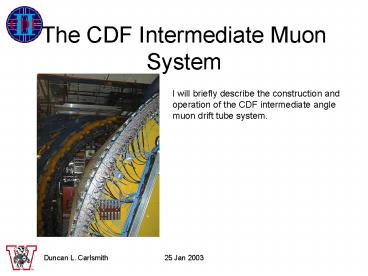The CDF Intermediate Muon System - PowerPoint PPT Presentation
1 / 25
Title:
The CDF Intermediate Muon System
Description:
barrel/toroid scintillation counters (Italy, MI State,WI) to tag bunch crossing. ... Steel welded to old toroids to shield the CMX and BMU detector systems. ... – PowerPoint PPT presentation
Number of Views:46
Avg rating:3.0/5.0
Title: The CDF Intermediate Muon System
1
The CDF Intermediate Muon System
I will briefly describe the construction and
operation of the CDF intermediate angle muon
drift tube system.
2
Intermediate Muon System
BMU-1700 drift tubes made in Madison, WI,
arranged in 4 layer barrel around steel absorber
to identify muons
BSU /TSU -250 barrel/toroid scintillation
counters (Italy, MI State,WI) to tag bunch
crossing.
3
IMU views
Interface to central detector
Rear face and quad. magnet
4
Extrusions
BMU 3 wide drift tubes are fabricated as four
cell stacks made from interlocking aluminum
extrusions of two kinds. 1/2 industry standard
tolerance extrusions were produced by Bower
Manufacturing (MI).
5
Electrodes
Cu strip electrodes shape the drift field. Two
electrode boards (10) slip into each tube.
6
Field shaping board production
12 x 12 Cu covered circuit board sheared to
width and length Custom machine to remove Cu
forming strips and clean Ends finished.
7
End cap assemblies
Plastic molded end cap assemblies provide
connections to electrodes, the gas seal, and wire
support.
8
End cap installation
Hardened steel jigs position endcaps and wires
relative to external fiducial pins.
9
Wire stringing
Gold-plated tungsten wire (50 micron diameter)
was fed through the endcap assemblies, tensioned,
soldered, and glued. Wire tension was checked
with an automated system which excited
oscillation and measured the frequency.
10
HV and preamps
Preamp
HV board
8-layer HV distribution board 4-channel
preamplier board Custom delrin HV
connectors Extruded/machined cover shroud
HV
Gas
Shroud
11
Quality Assurance
QA tests included electrical continuity, gas
seal, and beta source current along each anode
wire.
12
Cosmic ray and beam tests
Pion/muon beam tests - Resolution lt180 micron,
Wire placement error 200 micron Efficiency
100 Linear to within a few ns
Cosmic rays observed in two of the first
production stacks.
13
Mechanical support
Stacks are individually bolted to machined
support arcs mounted to steel. A slot/pin sets
azimuth. Arcs were fabricated from water jet cut
plate.
14
Absorber
Steel welded to old toroids to shield the CMX and
BMU detector systems. Four 180 degree sections
move on rails to provide access to the TSU and
to the central detector.
15
Time division
Jumper wires between cells at IP end.
Derive position of a muon along wire from time
difference.
Time difference vs position
Time difference distribution. Resolution 16 cm
16
Calibration systems
Fe55 sources (100 nC 5 keV X-ray) are installed
inside 42 cells distributed around the system for
gain monitoring. Amplified source signals are
available at front of ASD cards. The
preamplifiers and/or ASD cards may be pulsed for
remote electronics testing. Pulses are
distributed calibration cards in each of the four
ASD (RABBIT) crates.
17
BMU ASDs
Preamplified drift tube signals are sent to
Amplifier-Shaper-Discriminator (ASD) cards on
custom twisted pair cables. Four RABBIT crates,
power supplies, relay controls attached to the
absorber. Cables terminate on high density
connection boards .
RABBIT crate with ASD cards, Dan Cyr.
18
BMU High Voltage
HV for anode (5300 V) and electrodes (3900 V) is
fed to 36 sectors of 12 stacks from 1st floor
counting room. CAEN HV supplies are controlled by
a PC running NT.
CAEN HV system
19
Readout and trigger
ECL signals sent 200 to Michigan pipelined TDCs
(VME). L1 trigger electronics finds coincidences
stubscintillatorcentral track
20
BMU drift time distributions
21
Bunch timing from track fits
t0 (ns)
Fits of 4 hit stubs with offset cells for track
time allows us distinguish interaction and beam
halo associated hits.
22
CDF Run II ZgtBMU,CMU
23
Drift tube design and production
Considerations Performance resolution, multihit
capability, rate capability, proportional/streamer
modes. Cost channel count, complexity, parts
availability, readout, fabrication, delivery,
installation, mechanical mounting, alignment and
survey, high voltage, gas, cabling. Reliability
mechanical robustness, aging, gain stability,
electronic stability (cross talk, oscillation),
servicing Environment and safety mechanical
strength, flammability, HV, temperature, humidity
24
Little lessons
A tube or a few tubes together form a robust high
performance drift detector unit. A highly modular
design makes it easy to fabricate, test, service,
and replace a detector element.
Preamp/amp/shaper/disc quad ASICs providing
logic level output signals can further simplify
such a system.
25
Off-axis Detector
20 m x 20 m x 80 m low Z low rate tracking
calorimeter with few cm transverse segmentation.
A challenge! The spatial resolution of field
shaped drift detectors is unnecessary. Simplest
gas detector design might be X and Y planes of
simple (round or square) tube modules. Liquid
scintillator, proportional sense wires, RPCs?
These technologies could all work. Detailed
engineering, cost estimation, and production
planning is required.































